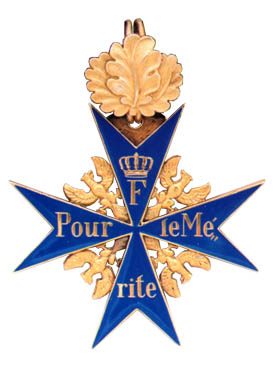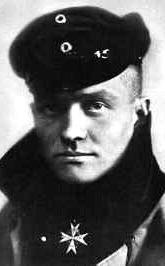|
|

|
The Pour le Mérite, known informally as the Blue Max, was Germany's highest military order awarded during World War I.
The award was first founded in 1740, named in French, the language of the royal court, for merit. Until 1810 the award was both a civilian and military honor. In January of that year, Prussian king Friedrich Wilhelm III decreed that the award could only be presented to serving military personnel.
In 1842, the Prussian king Friedrich Wilhelm IV founded the so-called peace class of the award, the Pour le Mérite für Wissenschaften und Künste (Order Pour le Mérite for Science and Arts), with the three sections humanities, natural science and fine arts. One of the most famous artists who received the peace class of Pour le Mérite was Käthe Kollwitz (she was deprived of it later by the Nazis).
In 1866 a special military Grand Cross class of the award was established.
It was during World War I that the award gained its primary fame. Although it could be awarded to any military official, it was most well known as an award for aerial combat. In the aerial war a fighter pilot was initially entitled to the award upon downing eight enemy aircraft. Ace Max Immelmann was the first airman to receive the award, after which it became known among his fellow pilots, on account of its color and its recipient, as the Blue Max — in German, Blauer Max).

The number of aircraft downed needed to win the award continued to increase during the war; eventually it became a requirement to down twenty enemy airplanes.
Recipients of the Blue Max were required to wear the badge, which was a blue Maltese Cross with eagles between the arms, and the royal cipher and the words 'Pour le Mérite' on the cross, whenever in uniform. Notable recipients included Manfred von Richthofen, better known as the 'Red Baron', Erwin Rommel, the famed "Desert Fox" of WWII, and Hermann Göring, later to become one of the most senior leaders of the Third Reich. The last living holder of the Pour le Mérite was novelist Ernst Jünger who died in 1998 and who, at the age of 23, was the youngest ever recipient as well.
The award was abolished along with Kaiser Wilhelm II's abdication on 9 November 1918.
In 1952, the President of West Germany, Theodor Heuss, revived the peace class of the order as an autonomous organization under the protection of the German President (although it is not a state order like the Bundesverdienstkreuz).
External links
fr:Pour le Mérite no:Pour le Mérite pl:Pour le Mérite nl:Pour le Mérite
